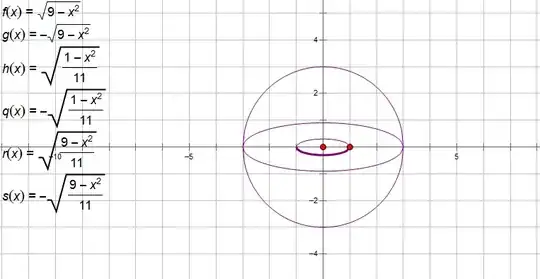We have equation of a circle, x2+y2=9.
Comparing with the standard equation of the circle (x−h)2+(y−k)2=r2
From the equation, the center of circle is (0,0) and radius is r=3.
We have equation of the curve, g(x,y)=2x2+10y2+6xy=1 … (1)
To find the center of the curve, we can find the normal to the curve.
It is given by, ∇g(x,y)=0
⇒gx=0 and gy=0
We can partially (1) differentiate w.r.t x, we get,
gx=4x+6y
gx=0
⇒4x+6y=0… (2)
We can partially differentiate (1) w.r.t y, we get,
gy=20y+6x
gy=0
⇒20y+6x=0… (3)
The point where the normal meet will be center of the curve.
Solving (2) and (3), we get,
Subtracting 4 times equation (3) from 6 times equation (2), we get
24x+36y=0−(24x+80y=0) 0x+116y=0¯¯¯¯¯¯¯¯¯¯¯¯¯¯¯¯¯¯¯¯¯¯¯¯¯¯¯¯¯¯
We get,y=0
. Now put this result in equation (1), we get x=0
(x,y)=(0,0)
Therefore, the center of the curve is also (0,0).
From the figure we can understand that the distance between the circle and curve is radius of the circle minus the distance from origin to the curve. As the radius of the circle is constant, the required distance will be minimum when the distance from the curve to the origin is maximum.
The distance from any point (x,y)
on the curve to origin is given by,
d=(x−0)2+(y−0)2−−−−−−−−−−−−−−−√=x2+y2−−−−−−√
⇒d2=x2+y2
d is maximum when d2
is maximum.
For maximizing, we use Lagrange multipliers.
We need to maximize f(x,y)=x2+y2 over the constrain g(x,y)=2x2+10y2+6xy−1.
By Lagrange multiplier,
∇f(x,y)=λ×∇g(x,y)
Taking partial derivative of f w.r.t x
fx=2x
Taking partial derivative of f w.r.t y
fy=2y
Taking partial derivative of g w.r.t x
gx=4x+6y
Taking partial derivative of g w.r.t y
gy=20y+6x
Applying Lagrange’s conditions, we get,
fx=λgx2x=λ(4x+6y)
On simplifying we get,
⇒x=λ(2x+3y)
⇒λ=x(2x+3y)
… (4)
fy=λgy2y=λ(20y+6x)
On simplifying we get,
⇒y=λ(10y+3x)
⇒λ=y(10y+3x) … (5)
On Comparing equations (4) and (5), we get,
x(2x+3y)=y(10y+3x)
On Cross multiplying, we get,
(10y+3x)x=(2x+3y)y⇒10xy+3x2=2xy+3y2
On simplifying we get,
⇒3x2+8xy−3y2=0
Making complete square,
(3–√x)2+2×(3–√x)×(43–√y)+(43–√y)2−(43–√y)2−3y2=0
⇒(3–√x)2+2×(3–√x)×(43–√y)+(43–√y)2=163y2+3y2
⇒(3–√x+43–√y)2=(16+93)y2=253y2

